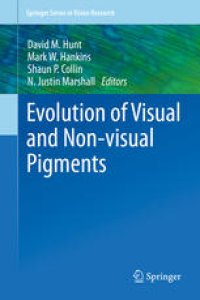
Ebook: Evolution of Visual and Non-visual Pigments
- Tags: Neurosciences, Ophthalmology, Cell Biology
- Series: Springer Series in Vision Research 4
- Year: 2014
- Publisher: Springer US
- Edition: 1
- Language: English
- pdf
Photopigments are molecules that react to light and mediate a number of processes and behaviours in animals. Visual pigments housed within the photoreceptors of the eye, such as the rods and cones in vertebrates are the best known, however, visual pigments are increasingly being found in other tissues, including other retinal cells, the skin and the brain. Other closely related molecules from the G protein family, such as melanopsin mediate light driven processes including circadian rhythmicity and pupil constriction. This Volume examines the enormous diversity of visual pigments and traces the evolution of these G protein coupled receptors in both invertebrates and vertebrates in the context of the visual and non-visual demands dictated by a species’ ecological niche.
Photopigments are molecules that react to light and mediate a number of processes and behaviours in animals. Visual pigments housed within the photoreceptors of the eye, such as the rods and cones in vertebrates are the best known, however, visual pigments are increasingly being found in other tissues, including other retinal cells, the skin and the brain. Other closely related molecules from the G protein family, such as melanopsin mediate light driven processes including circadian rhythmicity and pupil constriction. This Volume examines the enormous diversity of visual pigments and traces the evolution of these G protein coupled receptors in both invertebrates and vertebrates in the context of the visual and non-visual demands dictated by a species’ ecological niche.